Ayer Ski
Hill
Ayer, MA
1935-1936
History
~ Comments/Memories ~ Current Photo
Many thanks to Dick Kenyon,
who has discovered this nearly forgotten lost ski jump in Ayer, MA! Below is the
history he has dug up, along with images of this lost jump.
History
ONCE UPON A HILL IN AYER, MASSACHUSETTS by Dick
Kenyon
Was
Ayer Ski Hill a success or a disaster?
Imagine
this scenario. It’s February 1935. A group of dedicated ski jumpers decide to
fill a need for a ski jumping and winter sports venue in southern New England,
closer to those wishing to engage in winter sports who cannot afford to travel
north. Led by Anton Lekang, 1932 national jumping champion and Strand Mikkelsen,
1929 champion, members of the group drive over 2600 miles in southern New
England seeking a hill that meets five criterion. It must: be near a highway and
railroad to make access easy; have a north or northeast exposure to preserve
snow longevity; have adequate height and slope; have acceptable prevailing
winds; be in a region of reliable snow.
| In
April they choose Pingry Hill in Ayer, Massachusetts. Located just off
then Route 2 and 110, on Willow Road near a railroad, the hill also
meets the other criteria. A large trestle ski jump, designed by Anton
Lekang, is constructed in the fall of 1935 with an opening planned as
soon as enough snow falls. The entrepreneurs, now known as the Ayer Ski
Club, expect to attract paying spectators to watch ski jumping contests,
and other folks who want to participate in various winter sports on the
couple of hundred acres surrounding the jump. Parking areas are prepared
for 5000 cars. The complex is named Ayer Ski Hill.
(To
the right is a map from a flyer, showing how to reach the area) |
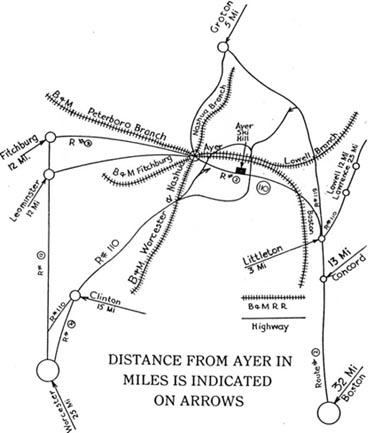
|
|
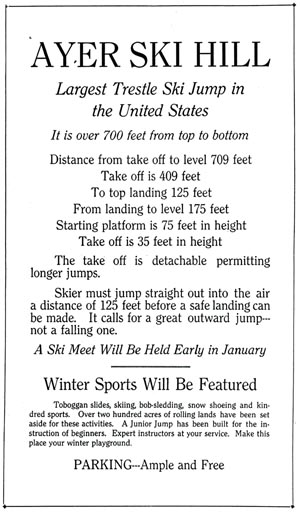
|
A flyer
is issued listing the design features of the ski jump, showing the
location on a small map and offering the slopes for skiing, tobogganing,
bobsledding and snowshoeing. According to the flyer, “Ayer Ski Hill is
The Largest Trestle Ski Jump in the United States, over 700 feet from
top to bottom. The distance from take-off to level is 709 feet; Take-off
is 409 feet; To top landing 125 feet; From landing to level 175 feet;
Starting platform is 75 feet in height; Take-off is 35 feet in height;
Skier must jump straight out into the air a distance of 125 feet before
a safe landing can be made; It calls for a great outward jump – not a
falling one.”
(To
the right is the flyer, showing all the details on the jump) |
| The
snow is late in coming and the opening is delayed until January 25,
1936. The snow has been packed on the ski jump by Clem Curtis and is
finally in great condition. The judges’ booth is draped with red,
white and blue bunting and American flags. At the opening Anton Lekang
takes the first jump, starting half-way up the in-run, but fails to make
the full distance between the take-off and the down slope of the landing
ramp. He bounces on the landing trestle, takes a nasty fall and slides
down the rest of the ramp to the ground, breaking his ankle. Jumping for
him is over for the rest of the winter. Only one successful jump is made
this day and the demonstration is stopped prematurely so adjustments to
the jump can be made to improve safety. On January 26th other jumpers
perform as scheduled, watched by thousands of spectators who park free
but pay one dollar admission. On subsequent weekends admission is
reduced to fifty cents.
(To
the right is a Boston Globe article showing the jump in January 1936.
Click on image for larger picture) |
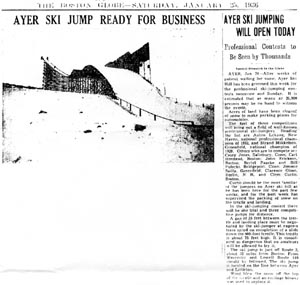
|
|
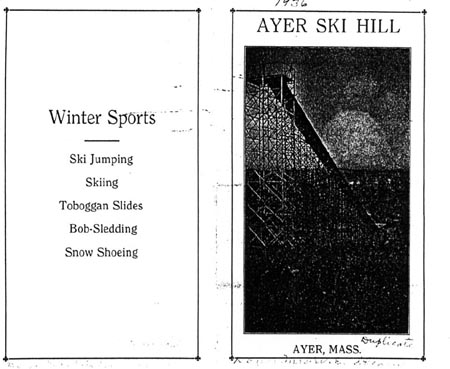
|
So much
for the scenario. Newspaper articles document further contests and
demonstrations including nighttime jumping under floodlights during
February 1936. Spectators arrived by auto and ski train. The lack of
snow that year forced an early end to activities. Data taken at the Blue
Hill, Massachusetts weather observatory in eastern Massachusetts, showed
a little over 12 inches of snow for 1936, the least of any year since
1885.
That
brief time from late January through the end of February 1936 seems to
be the only period of operation of this ski area. Weather, the
unpredictable element in the scheme, short-changed the Ayer Ski Club
that winter and finished them off that summer. According to a note on
the back of a photograph in the possession of the Littleton, MA
Historical Society, the in-run portion of the trestle blew down in
August 1936. It was not rebuilt. Perhaps this is the shortest life of a
ski area yet recorded.
(Left-from
the pamphlet on the area, showing the jump) |
Was Ayer Ski Hill a success or a disaster? The
historical facts supporting one conclusion or the other are still to be
discovered.
Comments
and Memories of the Ayer Ski Hill:
Dick Kenyon, Westford,
MA – In late July I was accompanied to the site of Ayer
Ski Hill by Alan Fletcher, owner of the Nashoba Valley Ski Hill. In the early
1950’s he owned most of the property on Pingry Hill on which the ski jump once
stood. He remembered seeing footings and cables at that time and thought he
could find them again. Unfortunately, after plowing through the woods,
underbrush and poison ivy we did not locate any prior evidence save for an area
that appeared to have been dug out of the side hill at one time which he
believed was where the end of the landing trestle was located. The area is now
overgrown. There is a commercial building at the foot of the hill on Willow Road
and a tire recycling operation further up and back on the hill. There is a cell
phone tower on top of the hill. (See picture below.)
The following statements were collected by Dick
Kenyon:
Clem Curtis, Stowe, VT –“Ayer Mass. was something else. What a disaster
that was. I don’t know who sponsored or built it but, I’m sure somebody lost
a bundle. Strand Mikkelsen made all the arrangements. I was asked to go there
and prepare the hill. I stayed at the farm that owned the land the jump was
built on. Wonderful people ‘cept the farm house had no water closet and it was
a cold seat. In the thirties there wasn’t a lot of people that could afford 50
cents to park in the parking lots when they could see it all from most any
place. The thing stuck up there like a poor ski jump. Which it was. I doubt if
they took in $100.00.” (July 2005)
(Note.
I think Clem intended to say the 50 cents was the admission to the ski premises
since the advertising flyer stated parking was free. His point still is valid.
Park for free and watch from the car.)( Dick Kenyon))
Denis Kane, Westford,
MA – “My uncle, Bert Little, owned a turkey farm only a
quarter mile from Pingry Hill. I was required to work there around age 10 in the
summers and at other times and watched the ski jump from the farm premises. I
remember that the trestle blew down but can’t recall the year. The wreckage
lay on the hill for years afterward and my uncle and I scavenged lumber from
it.” (August 2005)
Gertrude Membrino, Westford, MA –“ I remember going out to Ayer as a child to watch the
ski jumpers. I was worried that the jumpers wouldn’t be able to stop before
reaching the road. The landing are was quite close to the road.” (August 2005)
Stanley
Kimball, Westford, MA – “I recall going to Ayer at that time to watch
the ski jumping. There were a lot of cars along the road.” (August 2005)
Current
Photos
|
A
topo map of the area, showing Pingry Hill. The ski jump was likely on
the east facing slope. |
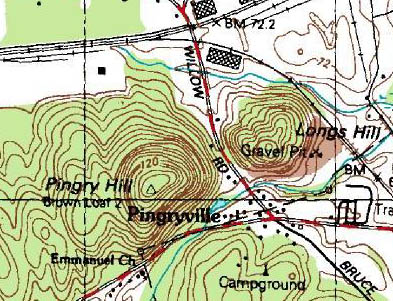 |
|
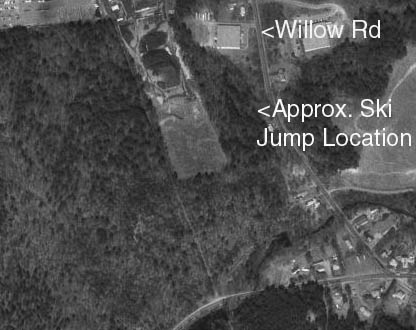
|
An
aerial shot shows little of the lost jump. |
| The
overgrown jumping site. No trace of the jump could be found. Note the
cell tower. |
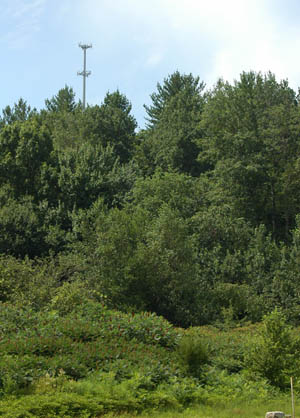
|
If you have more information on this area just let us know.
Last
updated: September 5, 2005
Head
back to Lost Massachusetts Ski Areas
Head
back to the Main Page






